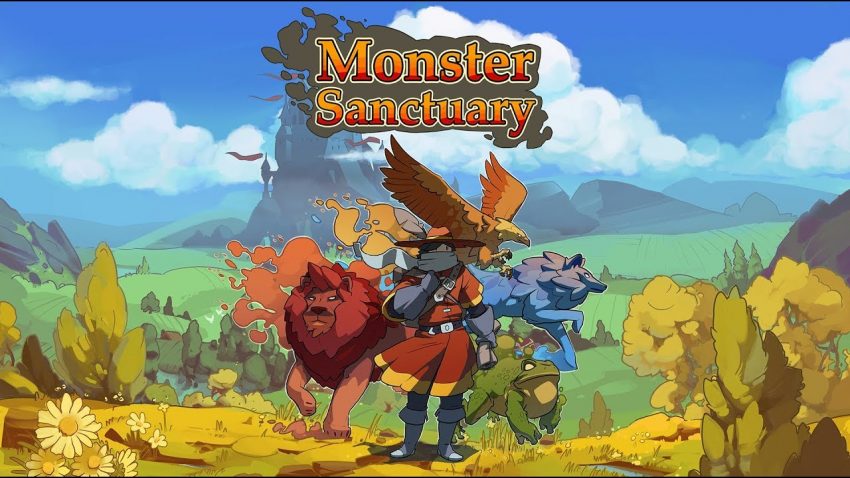For new players of Monster Sanctuary , this is a ramblin’ guide to the common pitfalls, mistakes and misses of newcomers to Monster Sanctuary, and how you can avoid them.
Introduction
Monster Sanctuary is game with a great deal of complexity to it in its many, many features. There’s many interesting platforming sections and abilities, a large selection of monsters to fill your team with, and a variety of “game modes” to fight in, like the Keeper Battles (and PvP) or the Infinity Arena. However, along your path through the game you are bound to fall into a series of pitfalls and mistakes that are common to the average beginner. This short guide intends to expose these “newbie traps” for you, so you can avoid them and improve your playing experience.
This guide will divide the so-called traps into five categories:
- Exploration
- Game Mechanics
- Teambuilding
- Monster-specific
- Skill-specific
Each one has its own section and will list them out.
BIG DISCLAIMER
Keep in mind, that the “traps” in question are actually a combination of rookie mistakes, lack of game knowledge and/or poor judgement. If I use terms like newbie, rookie or trap, I’m just being cheeky and don’t mean to offend. This guide is not intended to shame anyone who has fallen for any of these mistakes, everyone has at some point made them while playing Monster Sanctuary (I certainly did when I started out). Use these pointers as a way to improve your gaming experience or pick up good habits going forward.
So with that out of the way, onto the first section!
Exploration
You may on occasion find jumps that cut really close or that you can’t seem to make, especially early on. You may be able to make said jumps with Flying, however even then there are a couple of tough ones, like the one the leads to the Manticorb group in the Mountain Path. Both summon Small Rock and Summon Mushroom are actually better at giving you a height boost than normal Flying is, so if you use it instead you can easily make a double jump into the Manticorb area without pixel perfect accuracy or Improved Flying.
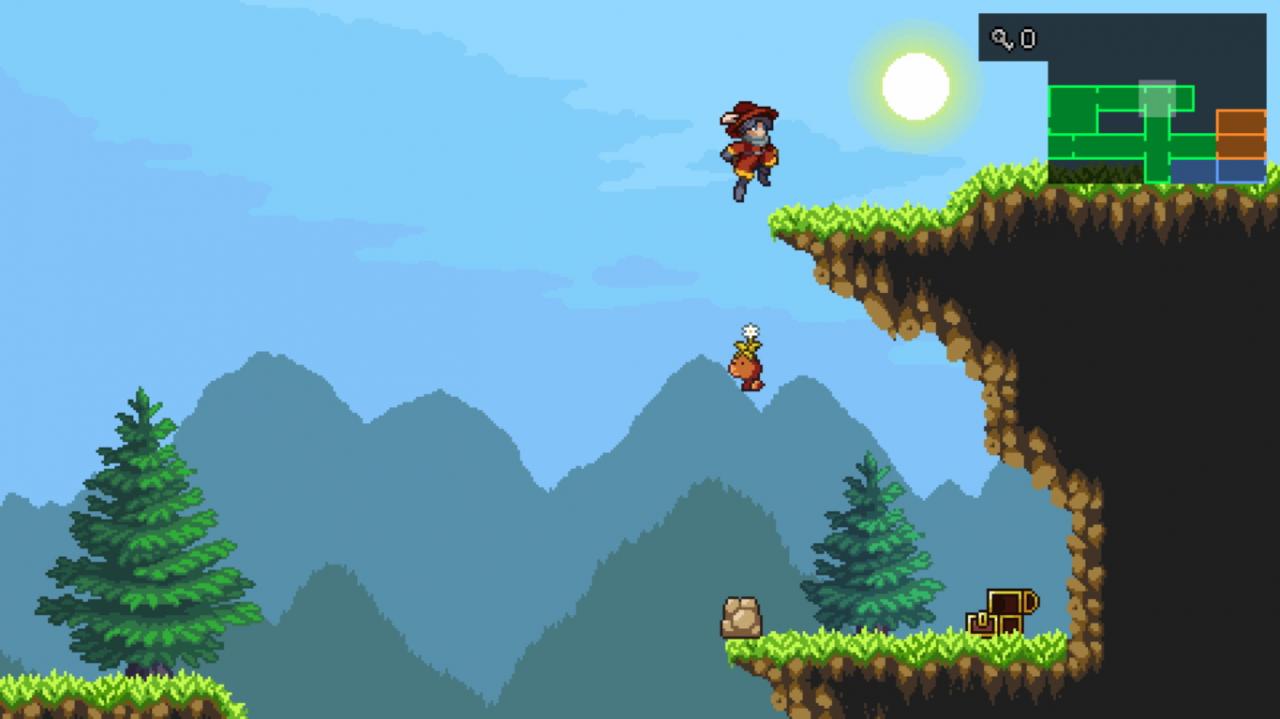 Like this!
Like this!
So don’t forget, you can platform off those rocks and mushrooms to reach new heights.
Mount speeds
They may not look it at first glance, because the camera moves with your character, but all mounts move faster than your character on foot. Some of them may feel slow, but it’s all an illusion, all mounts are functionally the same, so it’s all matter of preference. So, if you’re one of the three people that like to mount Moccus, by all means enjoy your speed boost!
This is a Metroidvania! (technically)
This means you don’t have to fulfill a sequence of events so the story unlock new areas for you. Instead, you can visit any area you want after the first two, so long as you have the exploration abilities to go there. Feel free to explore the world your own way, there are no real sequence breaks out there unless you happen to find a bug that messes with a barrier or so. With that being said…
You can’t really explore Horizon Beach until you find a monster that can swim. You can try all you want to jump/fly over the big pool at the entrance, but you won’t be able to cross it that way. So, as a hint: visit the Sun Palace first, you’ll to find that exploration ability there.
Game Mechanics
This is one of the most common omissions by new players. It is very often overlooked that you can switch between the monsters in battle and use them in whichever order they want, yet newbies always go with the default order of front to back. While you can definitely use this order in PvE by just putting the monsters of your trio in the order you want them, not using this feature in Keeper Battle formats really hurt your ability to do damage and take advantage of your combo meter. So, next time you’re in battle look at the top portion of the battle menu and learn your switch keys!

Look at the top, above your monsters’ portraits.
Ignoring non-skill actions
Just because the default option is skill usage, often players forget that they can do other things in battle beside them. The generic attack is obviously not good by any metric (Magic Attack is way better but still underwhelming), but it does allow your monster to recover mana while still doing damage. Items can be used in combat if you’re in a situation where you need a healing boost and you can also use Smoke Bombs mid-battle from this menu, if an encounter goes south midway through. Finally, don’t forget you can switch in monsters. It is rare to do switch-ins, but when it does matter it can make a big difference.
Not understanding how Damage Reduction works
Very often players will just crank up their Defense stat mindlessly to high heavens so their monsters are as tanky as possible. The problem with this is that unless your monster has Defense Overload to convert that value into Attack/Magic, you don’t want to take Defense up to ludicrous amounts. The value you actually need to check to know your defensive capabilities is Damage Reduction (DR), and how much of it you get from defense tends to decrease to more you have. Basically, it is much easier to hit a value of 45% reduction than it is to hit 60% reduction, because of how the formula calculates this. You can check this formula in the wiki here[monster-sanctuary.fandom.com].
PvP has a Forfeit button
Many people don’t know that you can resign from PvP matches, since most keeper battles against the AI don’t have that function, but it is there on the main action menu. So if you ever feel like giving up an online match, you know how to do it.
Team Building
The biggest rookie mistake when it comes to team compositions is an imbalance between attack and support. This is often the result of coming from games that don’t emphasize these kinds of synergy (like Pokémon, where supports are rarely if ever seen). This often results in teams where all monsters are built for offense, with maybe one or two token supports thrown in. The problem with too much offense is that if your supports die or are absent, you’ll lack a lot of survivability, as well as means to buff and/or deal with debuffs. The opposite is true of having too much support, in that you’ll get stalled from lack of damage output, though for newcomers this is much rarer.
 Example of an unbalanced team. Toad may be a healer, but Dracogran and Catzerker are both strong attackers that prefer to be the main DPS, so they overlap in function.
Example of an unbalanced team. Toad may be a healer, but Dracogran and Catzerker are both strong attackers that prefer to be the main DPS, so they overlap in function.
There is no straightforward solution for this problem, because in some teams it is better to tilt towards the offense or support. The reasons why you’d do this may not be apparent if you are not an experienced player, because you need to understand how the monsters of your team interact with one another to do so.
At the end of this guide there is a link to Rilvenar’s Beginner Tips guide, there you can read on the basics of team building. Be sure to check it out if you think you have this problem.
Having little or no healing/shielding
Piggybacking off the previous mistake, lack of survivability is of the biggest problem plaguing rookie teams. You may have access to healing items, however it is still important to have healing or shielding amongst your team’s support options. The reason should be obvious to anyone that has played RPGs before: These actions prevent you from losing party members. More members alive means your combo meter will be better off and you’ll have a better chance to snowball into a winning position. And of course, more members alive means you are further away from losing.
Additionally, Healthiness is an important part of your score in wild encounters, so keeping your party healthy is important to get five stars, both against normal monsters and champions.
 This team follows the a Healer/Buffer/DPS composition (in that order, left to right). Additionally, Promethean and Oculus provide some shields to improve team survivability.
This team follows the a Healer/Buffer/DPS composition (in that order, left to right). Additionally, Promethean and Oculus provide some shields to improve team survivability.
Overvaluing mana regeneration
Skills are almost always better than whatever the alternative is. But is being able to always be at peak mana to always use the best levels of a skill better? The answer is complicated and nuanced, due to a variety of factors, but this is thinking from a competitive perspective. For newbies the answer is simple by comparison: No, you don’t need as much mana regeneration as possible.
While having mana on hand to use your best moves is good, the main way of acquiring more mana regen is via equipment and this is a problem if you have an excess of mana regen equips. You don’t want to fill your equipment slots with mana regeneration items, instead try to think about how much you actually need for that particular monster and only get that much. As for how much is just right, my personal recommendation would be about three-quarters to exactly the amount of regen for your most used skill, not the most expensive one(unless your most used is your most expensive).
Finally, keep in mind that there is no shame in using a skill below its maximum level from time to time when your mana regen is not perfect, especially if it’s a support move. There are ways to correct a monster’s mana consumption when in battle, like applying Channel, spending a turn on item use, or even just using the generic attack. Mana regeneration is not the be-all, end-all.
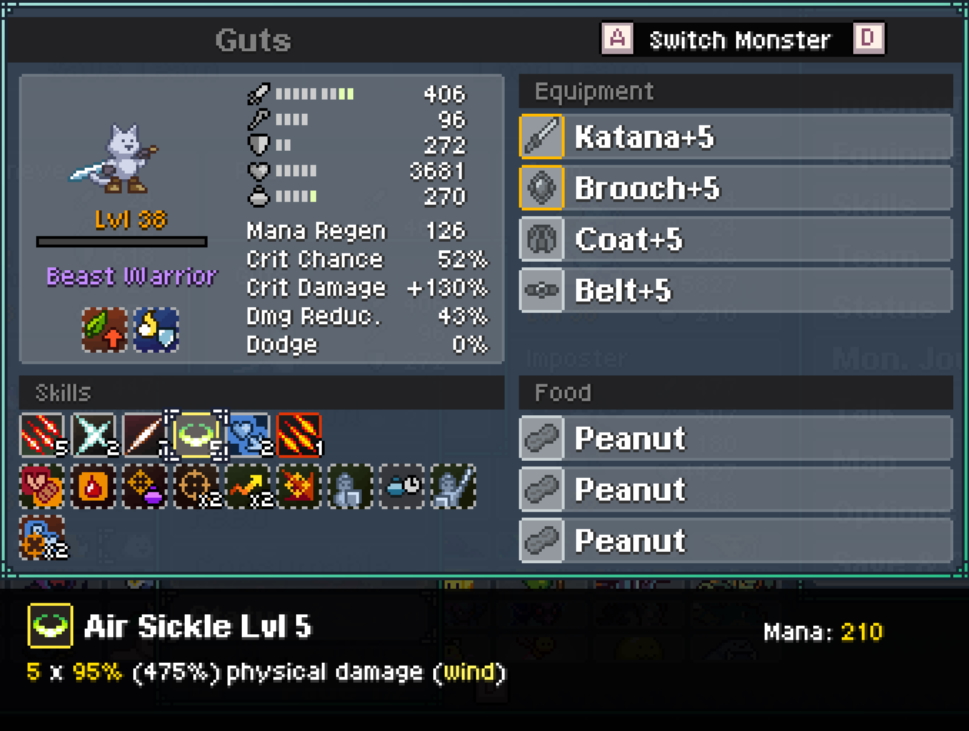 This Catzerker can get by with low Mana Regen thanks to Recuperate and using Long Slash Lv. 2 as its main move.
This Catzerker can get by with low Mana Regen thanks to Recuperate and using Long Slash Lv. 2 as its main move.
Lacking specialization
Another common blunder is not focusing on a particular plan when building monsters, instead going for a kitchen sink build that does a bit of everything. This is probably the worst way to approach your monster’s skill selection. Again this is often the product of Pokémon logic, where you want your mons to be as flexible as possible, since 1v1s are the most common playing format. Monster Sanctuary however, uses a 3v3 battle system, and that means your monsters out in the field can cover each other’s weaknesses. This is the same principle behind the traditional RPG team of Tank/DPS/Healer: Tank protects the team, DPS deals damage and healer keeps everyone alive. They each cover a niche that lets them work as a well-oiled machine, and so this is what you want to achieve in your teams too.
Now, I can’t really tip you on how to build your team to avoid this pitfall, since team building is a complex topic beyond the basics. You’ll gain the ability to improve on this front by experimenting with different teams and monster builds. However, do keep this in mind: you don’t need your monsters to do everything by themselves, they fight as a team, not on their own.
Too many active skills, not enough passives
This pit fall is probably not as common but is just as aggravating. Passive skills are just as good as active skills, yet many newbies may feel inclined to take active skills over passive ones simply because it’s harder to see the effects of the latter in combat.
For many monsters, passive skills are crucial to boost their active skills and take them to the next level. It pays off to avoid max level skills if you do not need them maxed out to begin with, especially once you are near the maximum level cap (40). If you never use Arcane Bolt Lvl. 5 on that monster because it never attacks, then you can don’t need it. Re-spec that skill to only get the levels you need to unlock things in that same tree that you do need/want and use the remaining points on other nodes.
In short, try to balance out your selection of passives and active skills and don’t get high level active skills if you don’t have a real reason to acquire them.
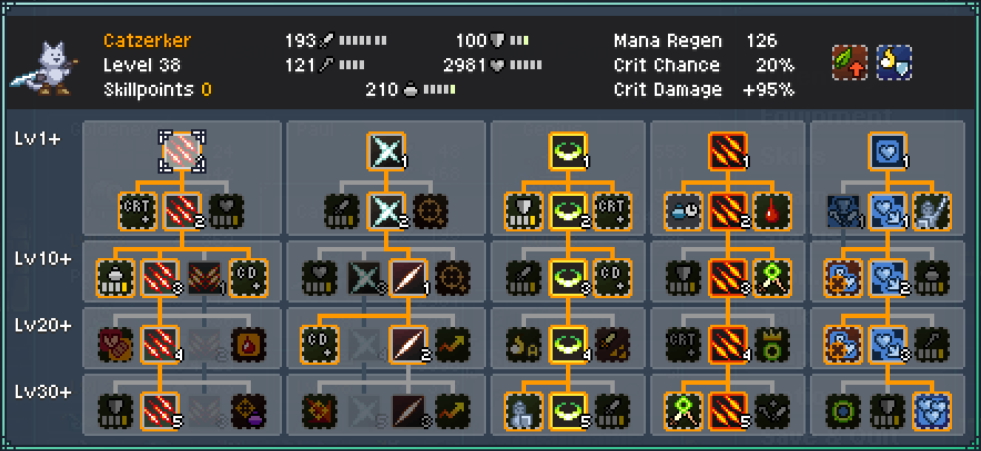 This poor guy is all over the place. The two mistakes pointed out previously both occur in this Catzerker’s skill set.
This poor guy is all over the place. The two mistakes pointed out previously both occur in this Catzerker’s skill set.
 By contrast, this other Catzerker is laser-focused on doing damage and buffing itself while doing it. Notice how the player only got what it thought it needed, rather than running down entire skill tree lines.
By contrast, this other Catzerker is laser-focused on doing damage and buffing itself while doing it. Notice how the player only got what it thought it needed, rather than running down entire skill tree lines.
Bad team synergy
Now this one is a bit more abstract, and therefore harder to understand if you are new, so don’t feel bad for this one if you don’t get it or fail to see it when in-game, even experienced players may fail this spot check sometimes. Do try to think about it when making teams though, since synergy can make it or break it in endgame matches.
Bad synergy is the result of flawed logic: thinking that a particular monster is good in X composition, when that is not necessarily true. While this problem shows up in many shapes and forms, it most commonly shows up is in buff or debuff strategies. All monsters tend to prefer one or the other, so understanding which way they tilt is important for your team to work effectively. Pairing Dracogran and G’rulu together on the surface seems OK, but these two have little if not nothing in terms synergy: the former is a buff-based attacker while the latter is a debuff-based support. There are some ways in which G’rulu can help Dracogran, but generally it’s not as good as, say, Dracogran and Salahammer, who are both buff-oriented.
Monsters
If you use these monsters, do not take this as an attack on them, they are here just so you can keep in mind that they are not all there is to Monster Sanctuary. With the right build any team can be used effectively in combat. There are some monsters here that I personally really enjoy using, but I do caution to not rely on them solely and to expand your horizonsby trying out the many others out there. You never know what monster might become your next favorite!

Catzerker
Perhaps the most obvious monster trap to newcomers. Catzerker is a good monster in its own right. It has a very strong AoE in its Long Slash attack, and has buff and first hit synergies out the wazoo to increase its power even more. That being said, it’s easy for you to become reliant on it for firepower when starting out. It is available in the first area, it hits like a truck and in PvE encounters its squishiness is not as much of a concern as in PvP. It may turn into a crutch for new players to deal with battles against the AI early on, but in the later keeper battles, and especially in PvP, its weaknesses become a lot more glaring. Finally, Catzerker has some skills that can be considered traps in and of themselves, but more on that later.

Tengu
If you were wowed by the impressive firepower of Tengu when you first found it in the Blue Caves, you are not alone. This monster is a beast of an attacker with its multiple mana boosts and its build is as straightforward as it gets: pile up mana, get Mana Overloads, break faces with 1-hit moves. The problem with Tengu is funnily enough the same reason why it’s so good: the mana stat pile-up. Pure stats don’t scale as well as other forms of attack boosting, like Heroics (aka. Heroism, Heroic Defense, etc.) or even simple crit-based damage. Why? Because they benefit from buffs and team synergies much more effectively than raw stats. Not only that, Tengu tends to be very hard to fit into teams in later parts of the game because it has almost no auras or support skills that benefit the team. In the end, Tengu ends up being hard to justify in the late portion of the game, but this may be hard to grasp at first because Tengu’s stats are so high, and so make it look a lot better than it really is. High stats are not necessarily all there is to an attacker, but you may not realize this when starting out.
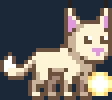
Caraglow
Examples of support monsters that become crutches are much rarer to find. Mostly because there is a tendency in newer players to prefer offensive monsters. However, Caraglow may be the closest thing to an exception. On paper Caraglow is a healer/buffer with very decent attack power, add onto that its excellent critical synergy and the large variety of healing moves and you are spoiled for choice. The problem with Caraglow is that it has too much going on in terms of active skills, to the point that a newer player will struggle find enough skill points for everything. Never mind that you can’t commit to all its healing skills, even if you build it as a pure support and ignore the Claws tree. Then there’s the problem of balancing its critical with how squishy and susceptible to the chill debuff it is (due to its Water weakness). Caraglow in the end seems amazing, but it is a bit of a questionable choice for newbies down the line, who may not realize the problems it has in the early portions of the game, only for the cons to slam them in the face in the lategame, when they’ve become so reliant on it that they’ve neglected getting alternatives.
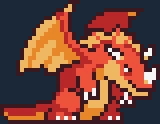
Dracogran
Dracogran is a beastly attacker, being able to self-buff and sporting one of highest, if not the highest overall stat potentials in the game. If the player overcomes its slight mana issues it becomes an incredible monster, and this is precisely why it can become a late game scenario that combines the excesses of Catzerker and Tengu, at the same time. Dracogran can deal incredible damage without much setup and even without a buffing support it can still do fairly well. This all means that Dracogran may seem like a “do it all” attacker to the inexperienced. Dracogran is squishier than it seems at first glance and a weakness to physical moves only makes it worse. It is a strong monster, but you cannot rely on its raw strength to blast your way into the endgame, you still need to a team to support it properly.
Skills
Finally, these are a few skills that you should not add mindlessly into your monsters’ repertoires, especially if you plan to get into PvP at some point. All of these skills are either situational or look better than what their real strength is due to the AI in PvE encounters being unable to properly exploit their weaknesses. You can probably get away with using them in wild encounters and even into the endgame’s keeper battles, but against other humans they will not work nearly as well.
Revive/Revival Items
![]()
Revival skills are a neat way of staying alive in battle, especially if you make use of the Necromancy passive alongside them. The Revive skill however can be much more situational than it seems at first glance. The problem with Revive is that, given how Keeper battles and wild encounters work differently from each other (with Keeper battles using your entire team), Revive is a lot harder to use in the former than the latter. In PvE it is easy to abuse revival skills stay in the game and win, but in the PvP format you can only use it on your last three monsters, so it’s a lot less likely to be effective. Ideally you should never need to use revives, if you do need to them then you may have some serious survivability issues you need to address, because your team is likely way too squishy. Revives should a last resort, not your main strategy.
Auto Heal/Auto Restore
![]()
.
![]()
If a skill/ability has “Auto” in the title, you can be 100% sure that newbies will gravitate towards it, since it make it sound like a skill that removes complexity for them. These two skills work very similarly, as both are passives triggered when attacking. Both Auto Heal and Auto Restore are unable to replace the mechanics they “automate” so to speak: healing and debuff removal. Their values are too low compared to healing from any active sources (skills and items). Many experienced players will tell you that Auto Heal is actually great to have if you can fit it in your builds, but it’s generally agreed that both “Auto-Recovery” moves cannot replace an actual healer’s role in your party. You can easily be deceived into believing that this helps you massively since passive healing works without your input, but this is simply not true. Passive healing is almost never at the same level as active healing (Multiple Regeneration buffs being the big exception here), so don’t think that these skills will keep your team healthy, they won’t. They will easily be outmatched by your opponents’ attacks. In fact…
All other Passive Healing
![]()
New players should avoid the mistake of relying on passive healing as their main way to recover health. Unless said passive healing comes from Multi-Regeneration (via mons like G’rulu or Druid Oak), passive heals are unable to provide you with decent health recovery to be useful as your main source of health. And then even Regeneration-based heals struggle to keep up without the occasional active healing skill if you’re up against decent attacking power. Now, that’s not to say all passive healing is bad, not at all, but in most monsters that have it in some shape or form it is intended as a supplement to active healing, not a replacement. So, don’t try to replace a healer with Transfusion or something along those lines.
“One-hit Wonders”
![]()
Amongst the many attacks in the game, the ones that look the most impressive are definitely the single hit ones. They hit once and they do it hard. It is important to know that these moves are not exactly a step above others with higher combo counts. These moves only work if they are able to get additional boosts, like being the last move of your turn (they get more damage from combo), and a plethora of passives. Also, it is important to note that on-hit effects may be harder to trigger with them. Finally, they get countered by Blind stacks much harder than other moves. Ultimately, single hit attacks are a bit of a gamble in most monsters that have them. Only a select few have the tools to use them to their maximum strength, and they 10000 damage in a single strike seems amazing, it’s not that far ahead of other boosted attackers’ damage outputs.
Protects
![]()
Finally, while diverting damage from your more fragile monster via Protect is a good idea, you have to keep in mind that there are ways to counter these kinds of move. Protect can easily be bypassed by an using a weaker attack first with which to remove the defending monster, then having the main damage dealer using its stronger attack. It can also be bypassed by AoE attacks, which ignore all moves that deflect damage, as they hit everyone in the opposing team. The real value of Protect lies in being able to deflect or at least provoke the opponent into using a sub-optimal move, by forcing it to target two attacks, when it could’ve done something else, like buff or shield his team. While Protect is fine in PvE (as the AI fails to understand how to deal with it), if you decide to make the move onto PvP, all of the above needs to be kept in mind, otherwise you could put yourself into a false sense of security.
That’s all we are sharing today in Monster Sanctuary Beginners Traps and How to Avoid Them, if there are anything you want to add please feel free to leave a comment below and we’ll see you soon.
Credit to Mithrik
Related Posts:
- Monster Sanctuary Item Grinding Without Using PVP or Infinite Arena
- Monster Sanctuary Beginner Tips and Detailed Explanation
- Monster Sanctuary MAP, Monster Location, Chest Location Guide
- Monster Sanctuary: MAP, Monster Location, Chest Location Guide
- Monster Sanctuary Ancient Woods Laser Puzzle Guide
